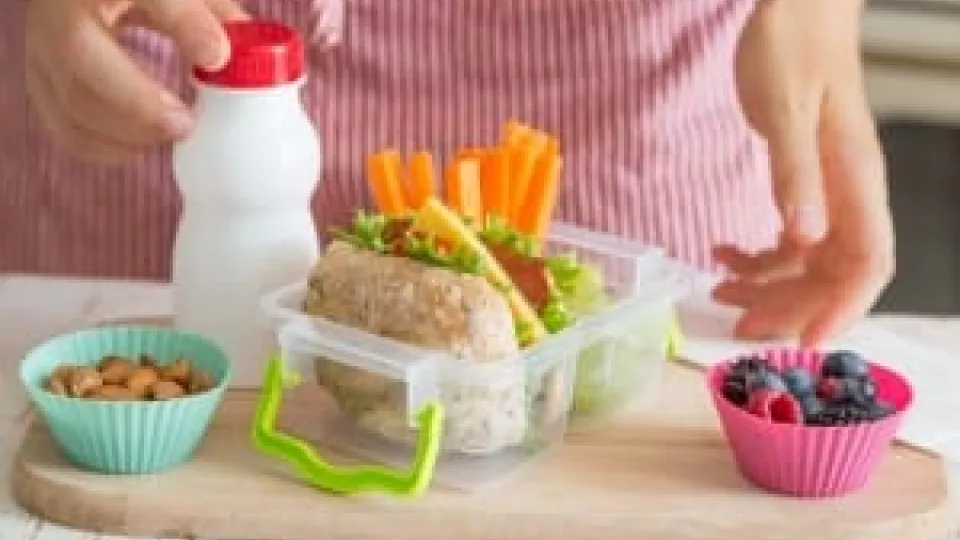
Let's Do Lunch!
Lunch is an important meal of the day for school-aged children. It gives them a chance to take a break from learning and re-fuel for the afternoon. The school year is well underway, and you may be debating whether to pack a lunch for your child or participate in the school lunch program. Both options have their good points. School lunches must provide a minimum amount of protein, fruits, vegetables, and whole grains on a daily basis, and are a good option for families with limited resources and time. However, they often include foods higher in sugar, fat, and sodium than is ideal (New rules aimed at lowering sodium content will lead to improvements over the next few years). Bringing a lunch from home allows families to have more control over what the child eats and reduces the time spent waiting in line for lunch. That may mean less waste, more healthful lunches, and more time to eat. However, a home-packed lunch is only as healthy as the foods it contains. Here are some tips to help your child get the most out of homemade lunches.
- Involve your child in packing. He or she can help select foods and may be able to help prepare the foods. Remember, you are the one in control of the choices, so let your child choose from foods that are healthy and nutritious.
- Include protein (i.e., meats, beans, cheese, eggs, nuts), healthy carbohydrates (i.e., whole wheat bread, whole wheat crackers, whole wheat pastas), a calcium source (i.e., milk or a milk alternative that has calcium, yogurt, or cheese) fruits and/or vegetables, and drink without added sugar (i.e., low-fat unflavored milk or water).
- Focus on whole foods and try to minimize highly processed or refined foods, which often have added sugar and will not provide the sustained energy your young scholar needs. This means using foods that are as close to their original form as possible. Whole grains, nuts (if the school allows), fruits, milk, and home-cooked meats are some examples of whole foods to choose. Deli meats, chips, white bread, fruit gummy snacks, and many packaged and prepared foods are less healthy options.
- Hydrate the right way. Water (try adding a slice or two of fruit for some color and flavor!) and low fat milk are good choices. Juice, sugary drinks (soda, Koolaid, Capri Sun, etc.), and flavored milks are less healthy and should be limited or avoided.
- Remember food safety. Foods that are usually refrigerated should be stored in a refrigerator or an insulated container with an ice pack to keep them cold and safe. These tools should be washed daily to keep germs away.
- Know your child’s heating options. If the child has access to a microwave, foods that need to be reheated can be included in the lunch. If not, only cold and room temperature foods should be sent.
- Try to minimize trash. Use reusable containers whenever possible and cut down on individually packaged foods, but be sure your child will have help opening their foods if they need it.
Here are some examples of healthy lunches (add low-fat milk or water as a healthy beverage):
- Hummus on whole wheat pita, string cheese, and pears dusted with cinnamon
- Chicken salad sandwich with cheese on whole wheat bread, natural popcorn, and carrot sticks
- Bean and cheese burrito on a whole wheat tortilla, banana, and almonds
- A hard-boiled egg, apple slices with peanut butter or almond butter to dip, and a cheese stick
- Whole wheat pasta salad (you can include some veggies, cheese, and beans!), fruit salad, and fat free Greek yogurt
- For more kid-friendly lunch ideas, visit www.healthyeating.org.
If participating in the school lunch program is the best option for your family on a regular or occasional basis, help your child make it as healthy as possible with a few guidelines. Choose unflavored milk to limit added sugars. Opt for fresh fruits and vegetables when available, instead of canned. Eat grilled, fresh meats instead of fried and processed ones (i.e., chicken nuggets or patties). Finally, ask the school for the menu ahead of time so you can help your child make the best choices or provide a home-packed lunch when the foods do not meet your child’s taste or nutritional expectations.
Have a great school year and eat well!


